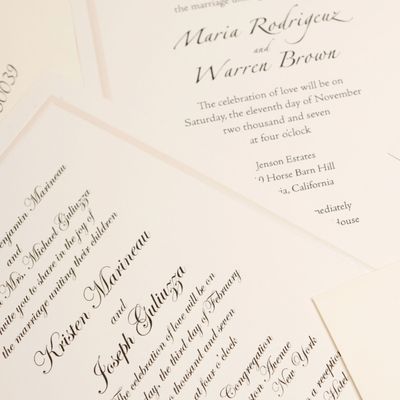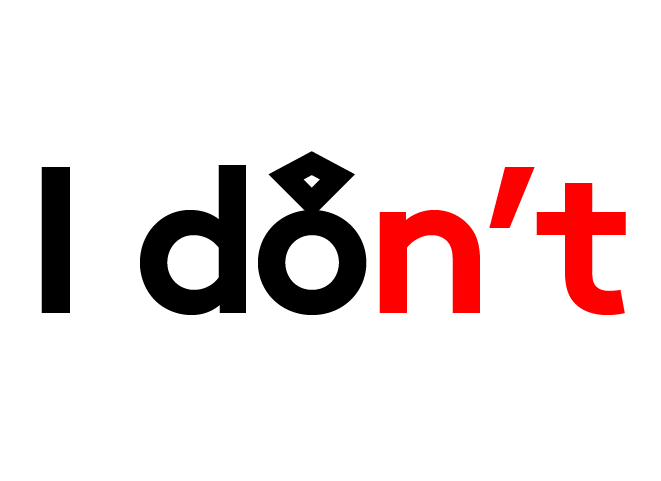
A weeklong series dedicated to skewering the traditions, expectations, and psychodrama that surround wedding season.
I got married a little over a year ago now, on the quick, and while I don’t regret it, I do still wonder what our wedding would have been like had we actually had time to make plans or try. The ceremony, the first dance, the party, the people, the flowers, the money spent — all that I can imagine. But where I get stuck, and always have, is the wedding invitation.
I know I would want it letterpressed. Then balk at the price. Then get sad. Then debate getting a bunch of postcards at the junk store and hand-writing them myself. Before you know it we’d have turned into amateur graphic designers, debating the merits of taking letterpress classes, arguing about whether our ideas were good-bad or just bad-bad. Whether we were trying too hard or not hard enough.
The wedding invitation is your names, together, in print: An announcement and an artifact. Also, a nightmare of self-presentation, an encapsulation of identity and taste, completely personal but usually devoid of personality. In an age of chatty oversharing, the wedding invite never has more than a few lines of text. It arrives unbidden in the mail, asking people to spend hundreds of dollars and watch you kiss publicly.
Most of me is so glad we eschewed it altogether. But then, without having gone through the wedding-invite gauntlet and emerged on the other side knowing, once and for all, whether or not we’re a serif couple, how do we know the aesthetics of our relationship?
Everyone has baseline decent taste these days, which makes it hard for shitheads like me to stand out. Thanks in large part to social media, collective aesthetic acceptability seems to evolve and disseminate and then trickle down in a matter of weeks. Have you wandered glassy-eyed around the home section of a Target lately? Everything is is $29 and everything is FINE. Post-Pinterest there’s really no excuse to have anything in your life, much less your wedding, that isn’t cute. Go to one of those custom-Christmas-card websites, pore over surprisingly inoffensive template options, upload your text into the template, and boom, you’re fine. Feeling flush? Enterprising women with Wacom tablets on Etsy will draw both of you and your dog.
And even if you do perfectly capture the taste and personality and exceptionalism of your relationship, a wedding invitation will always be inherently embarrassing to me. The idea of asking people I love for something they might not be able to say yes to makes me cringe. Weddings are so try-hard, so sincere and vulnerable; wedding invitations so open to judgment. “Please come watch us take a giant leap of faith and also kiss, PS here are some housewares we picked out on the internet for you to buy us.” (Is there anything more disarmingly revelatory than the wedding registry of someone you don’t know that well?)
The persistent tradition of sending wedding invitations — a big, nerve-wracking ask filled with intolerable aesthetic pressure — would be less baffling were it not for one thing: they don’t work. What is easier to ignore than a piece of fancy card stock, sent through the mail? My favorite cousin got married a few weeks ago and I missed it. I had a lot of legitimate excuses (we’d just done an overseas move, I had a huge deadline, we had no more room on our credit card), but I swear that if she’d invited me over Gchat I wouldn’t have been able to say no.
If there had been a Facebook event created for this wedding, and I saw all my cousins joining and posting things to each other, I would have peer-pressured myself into it. If there were emails that auto-generated a calendar notification, my brain would have treated it like anything else: a task, an obligation, something I need to spend an afternoon figuring out, preferably when I am supposed to be spending the afternoon doing something else.
I’m used to being downright harangued into attending so much as a poetry reading. Even our neighborhood farmers’ market starts flooding social media with photos of radishes and local honey, exhorting us to show up. There’s a pitch. You sort of come to rely on it. Like, “Yes, I want to go to that, but I know someone will bug me about it at least three more times,” and then you close the tab.
With wedding invitations there’s none of this. No begging. Less pressure. The invite is “tasteful” or cute or beautiful to behold and you’re so excited and then you’re doing something else and it languishes under a stack of bills or takeout menus. The very qualities that characterize the platonic ideal of a wedding invitation – polished, clear, concise, impressive — make it easier to ignore. Time passes and the bride and groom are too busy to personally nag every person on the guest list to let them know if they’re coming, and even if they did, I’m sure it would feel weird. “So, uhhh, no pressure, but, ARE YOU COMING OR NOT?”
Maybe wedding invitations are designed around our inability to say no. Imagine if instead of cute letterpressed cardstock the tradition was to write an overlong email to each person you wanted to come, explaining why it meant a lot to have them there. Or imagine if you ensnared each friend over coffee, asking them to their face to commit to coming. Everyone would say yes and then the morning of the wedding the bride would sit there crying as friend after friend texted to say they had to bail. I love weddings. When else do you get to slow dance, dress your kid up, eat cake? It’s the logistics that are hard. It’s the getting there. Maybe wedding guests should be comprised of only the people who are in a place in their life to get their shit together and send back the little RSVP card through the U.S. Postal Service.
(Does anyone actually RSVP to say, “No,” or do we all just block it out of our minds and tell ourselves we’ll figure it out next week and then you sort of forget and then suddenly flights are $1,000 and it’s time to text your apologies?)
It’s not until the wedding hashtag is popping up on Instagram that what was once a forlorn piece of cardstock becomes real life. That’s when the real event marketing comes into play: FOMO provides all the urgency missing from the wedding invite — but unfortunately it’s too late now. All you can do is follow along at home and feel regret and realize you should have made it work. You should have just put it on a credit card and shown up and eaten cake and felt expansive and cried a little and thought about what you would have done, had it been your wedding. How cute your names would look in a few lines of text, letterpressed in muted primary colors.





